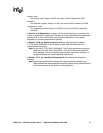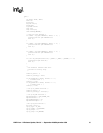
HMP Linux 1.2 Release Update, Rev 05 — September 2006September 2006 41
3.4.15 Voice API for Host Media Processing Programming Guide
In section 8.7.4 Streaming to Board Hints and Tips, the default bulk queue buffer size is
incorrectly described as 32 kbytes, rather than 16 kbytes. The second, fifth and sixth
bullets in that section should read as follows:
• The bulk queue buffer specifies the size of the buffer used to transfer voice data
between the application and HMP. This buffer is set to 16 kbytes and cannot be
modified; the dx_setchxfercnt( ) function, which is used to modify the bulk queue
buffer size, is not currently supported.
• Recommendation for the high water mark: it should be based on the following:
(size of the circular stream buffer) minus (two times the size of the bulk queue buffer)
For example, if the circular stream buffer is 500 kbytes, and the bulk queue buffer size
is 16 kbytes, set the high water mark to 468 kbytes (500-32=468).
• Recommendation for the low water mark: it should be two times the size of the bulk
queue buffer size.
Based on the previous example, since the bulk queue buffer size is 16 kbytes, set the
low water mark to 32 kbytes.
The following information is added to Section 1.6, Play and Record Features:
Transaction Record
The transaction record feature allows voice activity on two channels to be summed and
stored in a single file, or in a combination of files, devices, and memory. This feature is
useful in call center applications where it is necessary to archive a verbal transaction or
record a live conversation.
The following information is added to Chapter 8, Recording and Playback:
Transaction Record
Transaction record enables the recording of a two-party conversation by allowing two
time-division multiplexing (TDM) bus time slots from a single channel to be recorded. This
feature is useful for call center applications where it is necessary to archive a verbal
transaction or record a live conversation. A live conversation requires two time slots on the
TDM bus, but Intel voice boards today can only record one time slot at a time. No loss of
channel density is realized with this feature. Voice activity on two channels can be
summed and stored in a single file, or in a combination of files, devices, and/or memory.


















